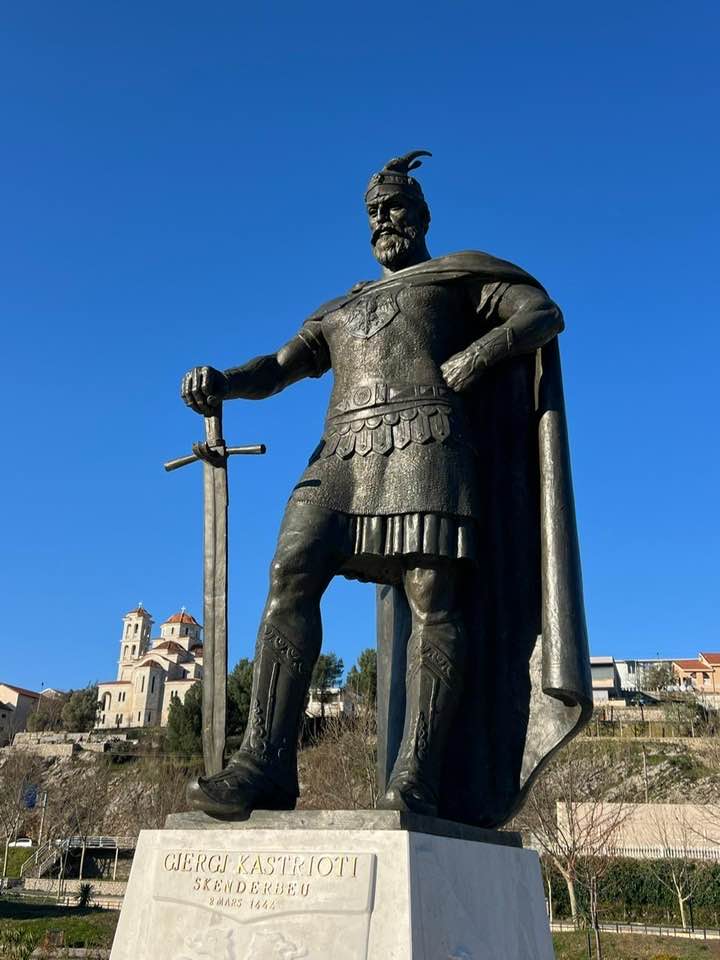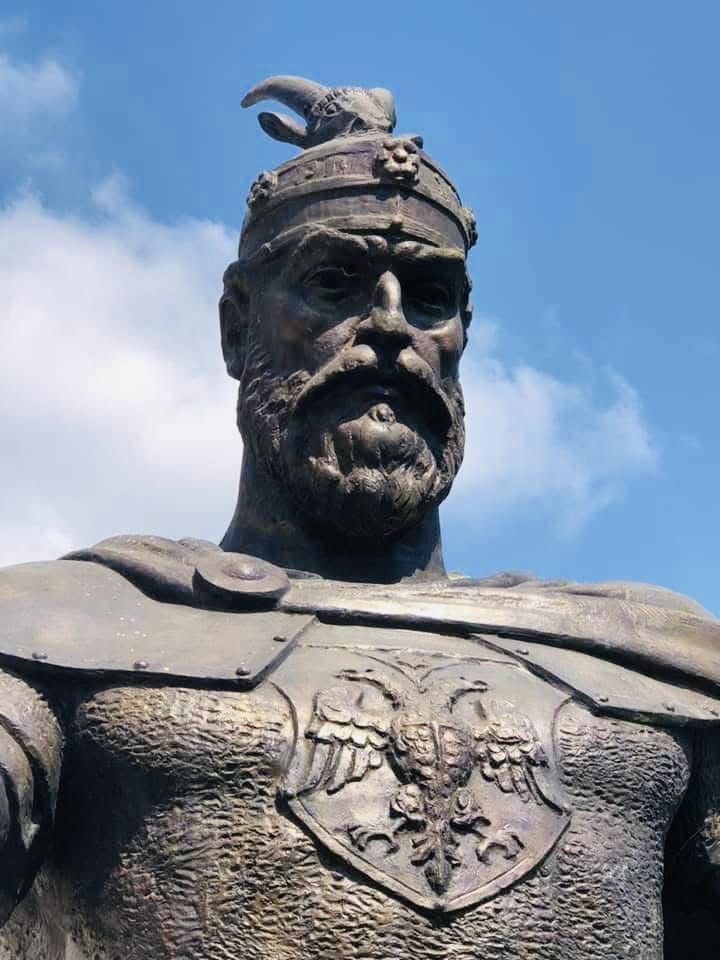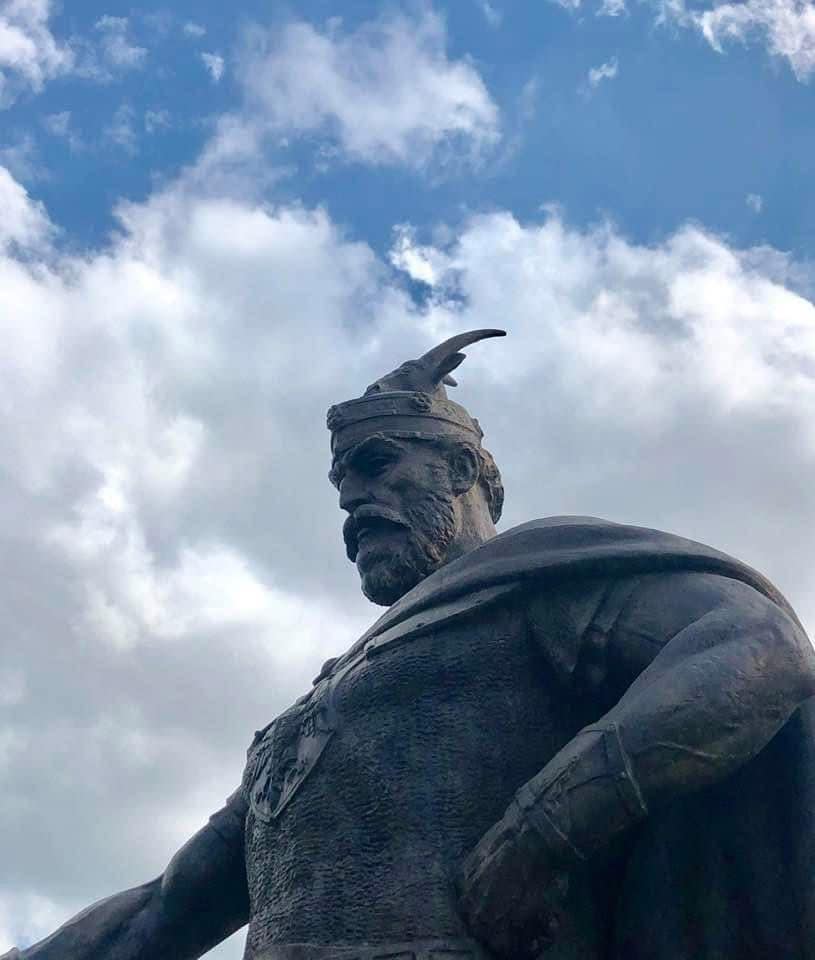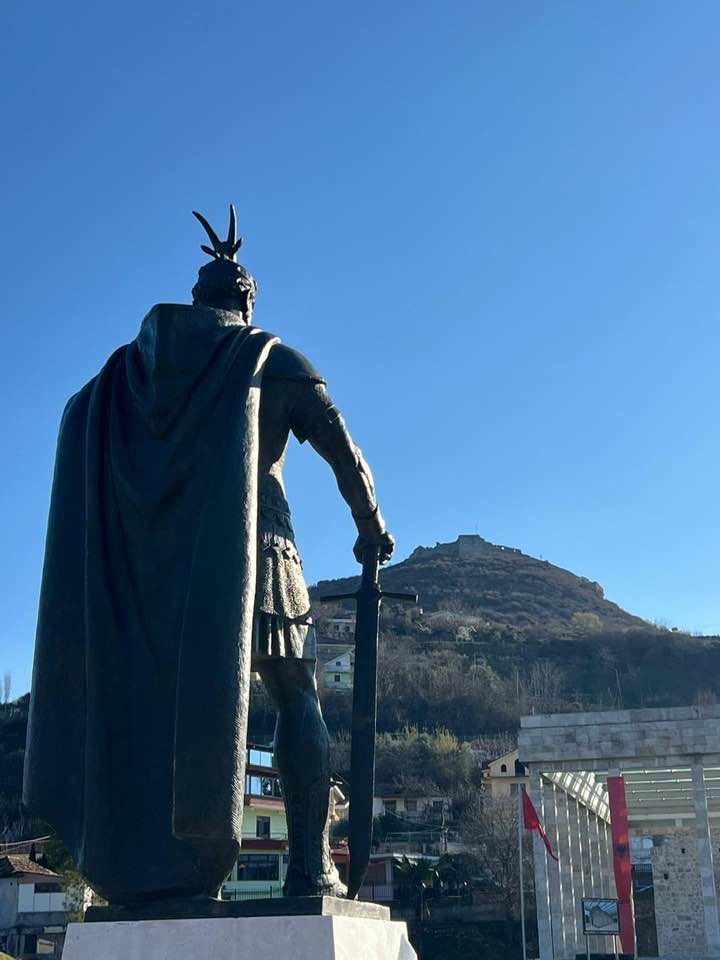Ardian Pepa's « Skanderbeg », a war strategist, adjacent to the throne of a legendary leader

By Albert Vataj
Of all the artistic lives of the name, the life and work of Gjergj Kastrioti-Skanderbeg, perhaps the most compelling is that of a leader, symbolized by what the statue located in Lezha, in front of the Skanderbeg Memorial, the work of the sculptor Ardian Pepa, inaugurated on March 2. Princes.
Works of art dedicated to Skanderbeg, especially sculptures, are often received with debates, pros and cons, for expressive stylistics, representative components and any distinctive element from earlier confrontations. Still this historical figure is unclear and aesthetic idealization has been the only identity that approximates its true image.
Regardless of how he is described and how he is immortalized, in historical evidence and documented facts, myth has gained, to conclude in the most commonly used features and features that have come to keep it in the legend configuration. Skanderbeg's statue, Ardian Pepa, is known for some features and features that distinguish it.
This statue is a magnificent representation of the figure of our national hero, which contains several layers of meaning, both aesthetically and ideally, and in the philosophical and historical plane.
His position and attitude. Skanderbeg appears in a dominant and authoritarian attitude. With one hand resting on the sword that stands vertically above the ground, a symbol of strength and willingness to war. The other hand above the waist gives the figure a safe and determined character. Both of these elements reflected in this work find direct links to the dedication that the author has made to this sculpture, emphasizing these details related to time and place.
The place where the statue is set, the time context, meaningful and historical. Skanderbeg came to a covenant with the Arberia and Arberia, to decide on the fate that would be derived, from the resistance that would become one of the most monstrous armies of the Ottoman. Skanderbeg is in the host state, symbolized with the right hand holding the sword and the left hand resting on the waist, the look of the arrow from top to bottom, and a more softened rigor, of the usual typology of this figure. Although it comes from the war and is cooked for war, pending decisions that will come out of the Lezha Assembly, it is followed in this communication in an expression of possession.
To dwell on other components. The armor and his dress are stylized according to the iconographic image of Skanderbeg known by historical paintings, with his characteristic goat horns, a symbol of war and wisdom. The tall cloak that unfolds behind it creates a sense of nobility and epic power, raising the image to an almost mythical dimension.
His portrait is not merely heroic, but also represents an unyielding spirit, a leader who does not swing before the challenges. This gives the work a deep psychological dimension and strength.
The monument is erected on a solid plinth, creating a visual effect that makes Skanderbeg's image look even more predominant over the surrounding space. This is to put this statue as a landmark that dominates the horizon. In himself he testifies to his legendary return to one of the iconic countries of the history of Albania, where he entered history to be immortalized in the memory of the Albanian nation and the memory of other figures of such dimensions and influences that he represented.
Compared to Skanderbeg's most popular statues, this of Ardian Pepa placed in front of the memorial, where he rests in always, has a softer and less aggressive, less dramatic stylization, but still preserves a strong presence. With a father, the teacher and a leader, he comes to this approach to resemble the idealized.
This statue is a combination of power and greatness, the leaders and the hero, myth and legend, placing Skanderbeg in a space that it perpetuates, as an uncontested figure of Albanian history, as an upper culmination of our consciousness, which extends to all Albanian and self -esteem, the temple of a holiness.
It is always a work that preserves a balance between historical reality and heroic idealization, while its main message remains clear, pride, strength and eternity of the value of the national figure.
Striving to see it beyond the restrictions, we note that Skanderbeg of Pepa, has some stylistic and conceptual affiliations with various artistic traditions and creative schools that exalted the act in the giant of brochures. Although it must be reconciled with the idea that the individual creative approaches they gain are those based on models and affiliations, parables and interpretations, which are occasionally attempted to be formalized in the creative act as unique.
What can be said, and that it also grasps a meaningful look at an endless look, this monument has a realistic and heroic approach, which puts the figure of Skanderbeg in a magnificent and monumentalized form. This approach is similar to the dictated aesthetic influences of the 20th century, where the hero is presented with a pronounced physiognomy, with strong lines and a predominant attitude, to be more than what you see, what you feel and the weight you have to face.
On the other hand, this style is also rooted in nineteenth-century Academism, where sculptures of national heroes such as Napoleon (eg its statue from Jean-Auguste-Dominique Ingres) or Garibaldi in Italy are presented with similar, imposing greatness.
The size of Skanderbeg, his static and symmetrical attitude, as well as attention to the details of the dress and armor, have a neoclassical spirit, similar to the portrayal of antique Greek and Roman heroes, are the roots of almost all traditions of monumentalism, because there was a dimensioning size and stylization. Because art is the only state of experience and reaction that dares to go where thoughts and imagination are listened to through an emotional substance.
Poses with a hand on the sword and the mantel that unfolds behind remembers the Primapore Augustus (famous Roman sculpture), where the Emperor emerges in a similar dominant attitude.
Also, the horned helmets and armor details bring it closer to King Leonida's representations of Sparta in classic Greek art, turning Skanderbeg into a mythical figure.
Although essentially a static and hieratic work, the long cloak that lies behind it, as well as the shape of the hat and armor, create a slight sensation of movement. This gives the statue a baroque element, comparable to the Bernin statues (eg « The Great Constantine » in the Vatican), where the attention to textures and the body gesture create a dramatic sensation.
Baroque sculptures often use the cloak and swagger to give greatness, as we see in the works of Gian Lorenzo Bernin, where the dress is not only decorative, but part of the visual narrative, what it will impose and seek.
The statue of Abraham Lincoln in Washington (by Daniel Chester French), also, where the figure stands in a magnificent and compelling attitude, or the statues of Garibaldi and Cavour in Italy, where national leaders appear with a strong and inevitable attitude on the pedestal.
This statue is a mixture of heroic realism, neoclassicism and baroque influences, creating a figure that resembles ancient heroes and great leaders of history, but also the earlier treatments made to this figure of history. It has a clear magnificent and mythical spirit, which goes beyond a simply historical portrayal, to enter the sphere of national iconography and the symbolism of immortality. Because art, monumentalism, size, strength, imposition, are elements that create a relationship with soda, allowing it to be emotionally involved in this experience, and why not awakening in that fantasy to return to the time of the hero and the developments, to allow them to be part of history, to be filled with the condition and feels it.
Skanderbeg is not only seen as a military commander, but as a more general and eternal leading figure. Because he is not left in the memory of history only as a war strategist, but also as a wise diplomat, a righteous leader and a visionary leader. He really belonged to the sword time, but more than with the sword, his victories are the product of ingenuity and experience.
If the others, but also Ardian Pepa himself in Skanderbeg's earlier treatments, puts Skanderbeg in a moment of war and action, this statue puts him in eternity, in the end of his mission, as a fulfilled leader.
Perhaps a legendary Skanderbeg, as a strategist and commander, today we would prefer a leader, a figure of unity, wisdom and prudence, but also determination and courage not to be afraid of the need to encounter. The sword and clothing show that it is ready for war, but more aspires to peace.












